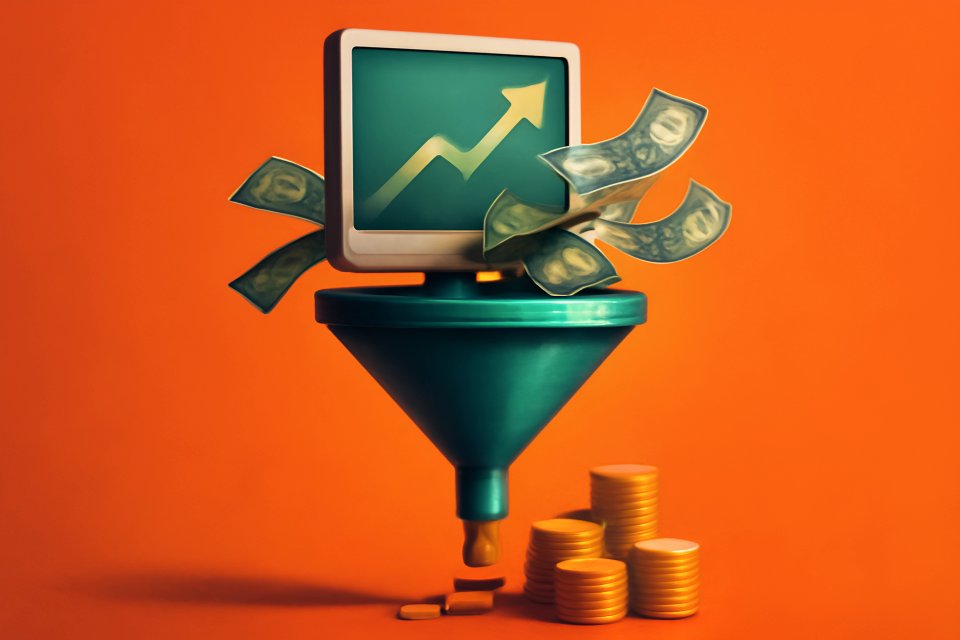
You scroll through your favorite blog, YouTube channel, or Instagram feed and think, 'I could do that.' The idea of sharing your passion and earning an income from it is electrifying, a jolt of pure potential. But then, the questions flood in, drowning that initial spark in a sea of doubt: Where do I even start? How do I find an audience? And how does this actually turn into money?
Let's be honest. The path from a brilliant idea to a bankable income feels foggy, cluttered with conflicting advice and gurus promising instant success. This overwhelming uncertainty is precisely why a staggering 78% of aspiring creators quit within their first six months. They have the dream, but they lack the blueprint.
This is your blueprint. Here at TheEarnist, we cut through the noise to give you a realistic, step-by-step roadmap. We’ll show you exactly how to start content creation for profit, breaking down the entire journey into four manageable phases. This isn't a get-rich-quick scheme; it's your guide to building a sustainable venture that respects your passion and rewards your hustle, one piece of content at a time.
Phase 1: Laying the Groundwork for Profitability
Before you ever hit 'publish,' the most critical work begins. This foundational phase is what separates the fleeting hobbies from the future empires. It’s where you build the strategic bedrock that will support your growth and, eventually, your income.
The Mindset Shift: From Passive Consumer to Active Creator
The first step isn't buying a camera; it's rewiring your brain. You must transition from someone who consumes content to someone who produces it with intent. This means adopting a growth mindset—the belief that your abilities can be developed through dedication and hard work. It’s this very mindset that prevents you from becoming one of the 62% of beginners who stall at the first sign of an obstacle.
This shift demands that you view your content as a business, even if it's just a tiny side hustle to start. It means embracing consistency over the paralyzing fear of imperfection. It’s about committing to the process, learning from your analytics, and understanding that your first video or blog post won't be your best—and that's not just okay, it's necessary for growth.
Your new mantra is progress, not perfection. You are now the CEO of your own small media company. Act like it.
Finding Your Niche: The "PEP" Test (Passion, Expertise, Profitability)
What should you even create content about? The answer lies at the intersection of three powerful forces, a framework we call the "PEP" Test. A winning niche must satisfy all three criteria to give you the fuel for long-term success.
First is Passion. What subject could you talk about for hours without getting bored? This is the emotional engine that will drive you to create content consistently, even on days when you don't feel like it. Second is Expertise. What do you know more about than the average person? You don't need a Ph.D.; you just need to be a few steps ahead of your target audience, guiding them on a journey you've already started. Many successful creators build their brand by documenting their own learning process, a strategy that builds incredible trust.
Finally, and most critically for our goal, is Profitability. Is there an audience willing to spend money here? A quick check for existing ads, sponsored content, or digital products in a niche will tell you if there's a market. For example, while entertainment niches get high engagement, personal finance creators often earn more per view—up to $15-$25 per 1,000 views—due to the audience's high intent to purchase solutions. To get a head start on this, you can explore a variety of proven niche side hustles to validate the income potential of your chosen topic.
Defining Your Ideal Audience: Who Are You Actually Talking To?
If you try to talk to everyone, you will end up talking to no one. Creating a simple "Audience Avatar" is a non-negotiable step to ensure your content resonates deeply. Give this person a name, an age, a job, and most importantly, a set of problems and goals. Are you talking to "Marketing Maya," a 35-year-old freelancer struggling with time management, or "Student Sam," a 20-year-old anxious about finding his first internship?
Knowing their specific pain points is your content goldmine. Maya’s frustrations can inspire content about productivity tools, while Sam’s anxieties can lead to videos on resume building. This level of specificity is magnetic. In fact, data shows that creators targeting narrow niches, like "vegan bakers" instead of just "bakers," see 53% higher audience retention.
Your avatar dictates your tone, your topics, and your platform choice. Every time you sit down to create, picture that one person and speak directly to them. This is how you transform passive viewers into a loyal community that feels seen, heard, and understood.
Choosing Your Core Platform: Where Will Your Content Live?
You cannot be everywhere at once, especially when you're starting out. Choosing one core platform to master is essential. Your decision should be based on your niche, your personal strengths, and your long-term monetization goals.
- Written Content (Blog, Substack): This is the king of SEO and building long-term authority. A blog is an asset you own, perfect for affiliate marketing and driving organic traffic. A single, well-optimized post can become a passive income engine for years.
- Video Content (YouTube, TikTok): Video is unparalleled for showcasing personality and building a strong connection with your audience. YouTube is a search engine powerhouse where creators can earn an average of $3-$5 per 1,000 views from ads, while TikTok is built for rapid, viral growth.
- Audio Content (Podcast): Podcasting creates an incredibly intimate bond with listeners, who often tune in during commutes or workouts. While monetization can be slower, it's a powerful medium for building deep trust and authority in your niche.
- Visual Content (Instagram, Pinterest): If your niche is highly aesthetic—like food, fashion, travel, or design—these platforms are your best bet. They are visual discovery engines perfect for driving inspiration and, eventually, product sales.
Phase 2: Building Your Content Engine
With your foundation set, it's time to start building. This phase is all about creating systems and workflows that allow you to produce high-quality content consistently without burning out. This is where your venture transforms from an idea into a tangible library of value.
Your Starter Toolkit: Essential Gear on a Budget
Let's bust a myth right now: you do not need a studio full of expensive equipment to start. The smartphone in your pocket is more than capable of producing high-quality video and audio. In fact, 92% of top TikTok creators use their phone's camera. The key is to focus on free and freemium tools that get the job done effectively.
For graphics, Canva is the undisputed champion for non-designers. For video editing, CapCut (on mobile) or DaVinci Resolve (on desktop) offer professional-level features for free. For crisp audio, Audacity is a powerful and free recording and editing software. Your most important tool, however, is a simple notes app for capturing ideas the moment they strike.
The goal is to keep your workflow simple. Master one or two tools before adding more complexity. For a deeper look at what can help you work smarter, not harder, check out these proven digital tools to boost productivity for online entrepreneurs.
Creating Your First "Pillar" Content
Your first few pieces of content should include at least one "pillar" post or video. A pillar is a substantial, comprehensive piece of content that covers a core topic in your niche from top to bottom—think "The Ultimate Guide to..." or "Everything a Beginner Needs to Know About..." This piece acts as a cornerstone for your brand, establishing your authority immediately.
This strategy is incredibly powerful for search engine optimization. Brands that implement a pillar page strategy see, on average, 58% more organic traffic within six months. Your pillar content becomes a central hub that you can link out from to smaller, more specific "cluster" content, signaling to algorithms that you are an expert on the subject.
This isn't just about pleasing algorithms; it's about serving your audience. A pillar piece provides immense value upfront, making it a powerful tool for capturing email subscribers and earning your audience's trust from day one.
Establishing a Sustainable Content Cadence
Burnout is the silent killer of content ventures. The pressure to post daily across multiple platforms is a trap that leads to mediocre content and exhaustion. The secret to longevity is not frequency; it's consistency. A predictable schedule, even if it's just one high-quality video or blog post per week, builds trust and anticipation with your audience.
The key to maintaining this consistency is content batching. Dedicate one day to outlining your content for the month, another day to filming or writing, and a third to editing. This workflow is far more efficient than trying to create from scratch every single day. To master this, you need a plan, and this guide to developing a consistent content calendar is the perfect resource to turn your planning into predictable growth.
Once you have a system, you can explore ways to build a multi-platform side hustle productively by repurposing your core content. That one weekly video can be stripped for audio for a podcast, transcribed into a blog post, and chopped into clips for social media.
Solve a Problem: Every single piece of content must answer a question or solve a specific problem for your audience avatar.
Focus on Quality over Quantity: One deeply researched, high-value post is infinitely better than five shallow, rushed ones.
Develop a Simple Workflow: Keep it simple:
Idea -> Outline -> Create -> Edit -> Publish -> Promote. Repeat.
Phase 3: Finding Your People and Building a Community
Creating great content is only half the battle. Now, you need to get it in front of the right people. This phase is about strategic promotion and turning passive viewers into an engaged community that champions your work. Your goal here is to find your first 1,000 true fans.
The "One-Two Punch" Growth Strategy: On-Platform & Off-Platform
Effective growth requires a two-pronged attack. First, you must master On-Platform promotion. This means using the native tools of your chosen platform to your advantage. For a blog, this is Search Engine Optimization (SEO). For YouTube, it's crafting keyword-rich titles and descriptions. For Instagram, it's using relevant hashtags and engaging with other accounts in your niche.
Second, you must engage in Off-Platform promotion. This is where you go to the digital water coolers where your audience already hangs out. Share helpful advice (not just links to your content) in relevant Reddit communities, Facebook groups, and on Quora. Data shows this is incredibly effective, with 73% of creators gaining their first 1,000 followers through strategic participation in 3-5 of these existing communities.
This dual approach ensures you are both building a long-term, searchable asset on your platform and actively driving immediate traffic from communities that are hungry for your expertise.
From Views to Community: The Art of Engagement
A view count is a vanity metric; a thriving comments section is a sign of a healthy business. Your job is to transform passive consumption into active conversation. Engagement is a two-way street, and you must make the first move.
Make it a rule to respond to every single comment you receive, especially in the beginning. Ask direct questions in your content to prompt responses, such as, "What's the biggest challenge you're facing with this? Let me know in the comments." This creates a valuable feedback loop that not only builds community but also gives you an endless supply of ideas for future content.
This is how you build a tribe. You move from being a broadcaster to being a community leader. When people feel heard and valued, they are far more likely to share your work, defend your brand, and, when the time is right, buy from you.
Phase 4: The Monetization Roadmap
This is the moment you've been working towards: turning your content into cashflow. But monetization is an art. Rushing it can destroy the trust you've worked so hard to build. This phase is about strategically introducing income streams in a way that feels natural and valuable to your audience.
The Golden Rule: When is the Right Time to Monetize?
The golden rule of monetization is simple: build value and trust first. Don't even think about asking for a sale until you have a loyal, engaged audience. A good benchmark is reaching 1,000 true fans or subscribers. Attempting to monetize too early is a critical mistake; surveys show that 79% of users will unfollow a creator who pushes products before providing consistent, demonstrable value.
Listen for audience signals. When people start asking, "Where did you get that?" or "Do you have a guide on this?"—that's your green light. They are literally asking for ways to pay you. Until then, your focus should remain 100% on serving your community.
Monetization is not the starting line; it's the natural byproduct of the value you've created.
The "Crawl, Walk, Run" Approach to Your First Dollar
To make monetization feel less intimidating, we use the "Crawl, Walk, Run" framework. This approach allows you to gradually layer in income streams as your audience and authority grow.
Crawl (Easiest to Start): This is where you begin. The easiest and most authentic way to earn your first dollar is through Affiliate Marketing. You simply recommend the products and services you already use and love. When someone makes a purchase through your unique link, you earn a commission. This is a perfect way to monetize your content blog or YouTube channel without creating a product yourself. For a complete playbook, explore these strategies for leveraging social media for affiliate success.Walk (Requires Audience & Effort): Once you have an engaged audience, you can move to the next level. This includes Ad Revenue from platforms like the YouTube Partner Program or ad networks for blogs. You can also begin selling simple Digital Products, like a $15 eBook or a set of templates that solve a specific problem for your audience. This is also the stage where you can attract your first Brand Sponsorships, with brands paying $50-$200 per post for access to your dedicated micro-community.Run (Advanced/Requires Strong Brand): This is the most profitable stage, reserved for when you are a recognized authority in your niche. Here, you can launch premium products like Online Courses that package your expertise into a high-ticket item. You can also offer Coaching or Consulting services, and you can compare freelance platforms to find your first clients. Finally, you can create recurring revenue through Memberships on platforms like Patreon, offering exclusive content to your most dedicated supporters.
Conclusion: Your Venture Starts Now
We've journeyed from the spark of an idea to a clear, actionable monetization plan. You now understand the four critical phases: laying a strategic Foundation, building a sustainable content Engine, implementing a smart Growth strategy, and finally, executing a thoughtful Monetization roadmap. Building a profitable content venture is a marathon, not a sprint. It's a game won through patience, consistency, and an unwavering commitment to providing genuine value to your audience.
The fog has lifted. The path is clear. You now have the blueprint that has taken countless creators from zero to their first paycheck and beyond. The journey of starting a digital content venture begins not tomorrow, not next week, but right now, with a single, decisive step.
What's the first action you'll take after reading this guide? Will you define your audience avatar? Will you outline your first pillar post? Share your commitment in the comments below.














